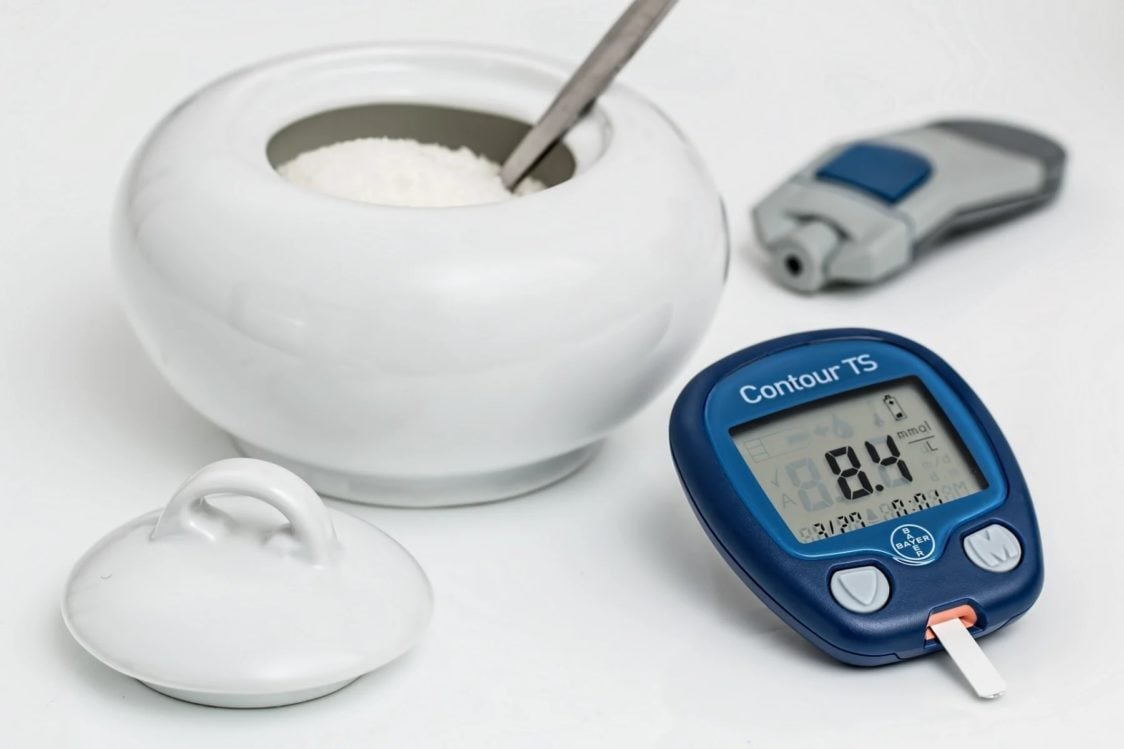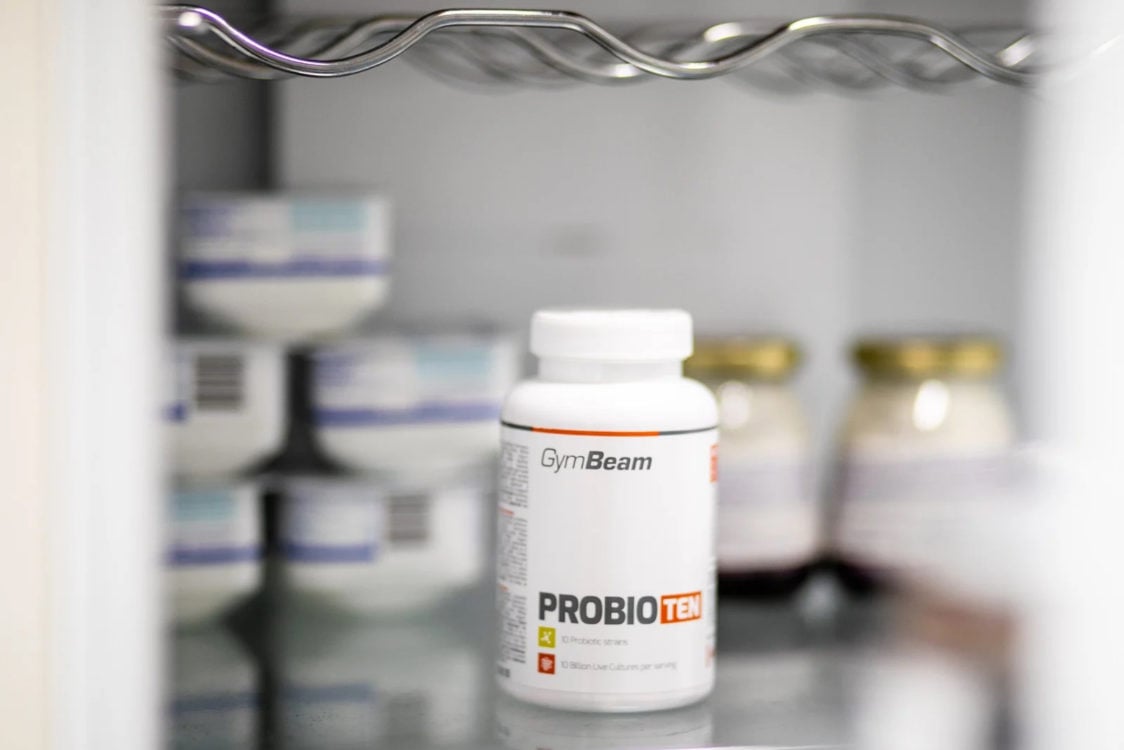Table of Contents
Insulin is the hormone responsible for the absorption of sugar in the bloodstream. Insulin sensitivity problems can lead to serious health problems. Read about insulin, insulin sensitivity, insulin resistance and the best ways to improve insulin sensitivity in order to maintain overall health.
Insulin and its functions

Insulin is a hormone produced in the pancreas that is located behind the stomach. Thanks to insulin, the human body can utilize or store glucose from carbohydrates. It is important for levels of sugar in blood and they are kept in normal thanks to insulin. [1] [2]
During the food consumption, carbohydrates are broken down into glucose which then goes into the bloodstream. At the same time, insulin is secreted into the blood and it attaches to special cells to allow glucose to be absorbed into the cell. The higher the blood glucose level, the more insulin is produced that balances it. However, in addition to this function, insulin is also involved in the breakdown of fats and proteins for the purpose of gaining energy. [1] [2]
Problems with the level of insulin in the modern world are not unusual and they can cause several serious health problems and complications. There are many problems associated with insulin which may result in insufficient or complete production of insulin as a result of the immune system’s attack on insulin-producing cells. Another frequent problem is the so-called insulin resistance which refers to the inability of cells to respond to insulin. [1] [3] [4]
This causes poor glucose absorption and its utilization as an energy source. If you have not heard of insulin resistance so far, you might be surprised at its frequent occurrence in society. Up to 32.2% of the US population may have this type of disorder, with every third child or adolescent with obesity also having insulin resistance. [1] [3] [4]
Insulin sensitivity
Insulin resistance and insulin sensitivity are related, more precisely higher sensitivity is also lower resistance, and vice versa. High sensitivity to insulin causes a better ability of cells to utilize glucose from the blood, thereby lowering the level of glucose in blood. This implies that resistance is harmful and sensitivity is a sign of a good health. Each of us has a different sensitivity to insulin and its level varies in dependence on our lifestyle, exercise and diet. A change of lifestyle can improve insulin sensitivity, thereby preventing insulin resistance and other complications such as prediabetes and type 2 diabetes. [4] [5]
Insulin resistance varies in dependence on our lifestyle, but there are specific factors that may cause this condition: [4]
- High content of fats in blood – according to several studies, a significant amount of free fatty acids in blood causes a problem with cell response to insulin
- Inflammation – an increase in inflammation and oxidative stress may be a reason for resistance
- Intestinal microbiota – an imbalance in the intestinal microflora is one of the reasons for resistance, because disruption of bacteria in the digestive tract can lead to inflammation
- Physical activity – more precisely inactivity, since activity increases insulin sensitivity and passivity leads to resistance
There are many factors that cause insulin resistance, including high carbohydrate levels in the diet, smoking or family diabetes. Resistance is more likely to occur in people over 45 years of age and in people from Africa, Latin America or in Native Americans. [8]

Symptoms of insulin resistance
There are symptoms that indicate a risk of insulin resistance, but to be 100% sure, a blood test and a blood sugar test are required [4] [8]:
- Waist circumference over 101.6 cm for men and 88.9 cm for women
- High level of insulin (on an empty stomach)
- Blood pressure levels – at 130/80 and above, there is a risk of resistance
- Skin tags and skin condition acanthosis nigricans
- HDL cholesterol levels – above 40 mg/dL in men and 50 mg/dL in women
- Level of triglycerides above 150 mg/dL (on an empty stomach)

Why is insulin resistance dangerous?
Insulin resistance is a condition that signals that our organism is not going in the right direction. It can develop into prediabetes and type 2 diabetes, but it also increases the risk of cancer, heart attack and stroke. [15] [16]
Prediabetes is not diabetes alone, but this does not mean that it is not dangerous. The betrayal of the prediabetes is that it has virtually no symptoms. One of the possible symptoms that can signal prediabetes is the darkening of certain parts of the body, for example the areas around the neck, elbows or knees. Although the direct reasons for the occurrence of prediabetes are unknown, overweight and lack of physical activity are other important factors besides genetic predisposition. [17]
The body of people suffering from insulin resistance, prediabetes and type 2 diabetes is burdened with high levels of insulin and sugar in blood. The consequence of these difficulties is a high risk of cardiovascular diseases and resistance alone doubles the risk of stroke and heart attack. At the same time, it triples the chance that your body will not survive heart attack or stroke. [16]
Insulin resistance increases the risk of prediabetes and it may lead up to diabetes and other complications. Therefore, other problems associated with blood sugar should be considered far before the development of insulin resistance. [3]
You might be interested in these products:
Why is the proper level of insulin important?
Very little or too much insulin in the bloodstream is a problem for people. A level of insulin that is too high will cause “your blood sugar to drop”. This is called hypoglycaemia and it may occur if a person injects more insulin than necessary. The body responds by eliminating glucose from the liver to get the body back to its optimal state. Hypoglycaemia is dangerous, because it may cause a seizure or loss of consciousness. [6] [7]
A low level of insulin is also a dangerous case, since it causes glucose to remain in the bloodstream. As a result, the amount of glucose begins to increase to the point where glucose also gets to the urine. Therefore, more water will also get into the urine, causing a person to urinate more often, be thirsty and dehydrated. A more important problem is the inability of cells to obtain energy from glucose which causes them to take energy from other sources, such as muscle or fat. As a result, one can get sick, feel tired and also lose weight. If the condition gets worse, it can lead to falling into coma and eventually to death because the body will begin to produce acids as waste products in an effort to gain energy from fats. For this reason, it is necessary for diabetics to control and replenish their insulin levels. [7]
Patients with type 1 and type 2 diabetes suffer from insulin deficiency. Do you know the difference? [7] [9]
- Type 1 diabetes – the body does not produce insulin. This is a low or zero content of insulin, because the antibodies have destroyed the substances that produce it. Lack of insulin causes glucose in the bloodstream to be absorbed and to remain in the blood.
- Type 2 diabetes – the body does not respond well enough to insulin and it may later stop producing it in the required amount. Thus, two situations may occur, insulin producing cells may have difficulty in producing it, so only a small amount is produced. The second situation is when there is enough insulin, but the insulin receptors where the insulin has effect will cease to be sensitive and will not respond to insulin in the blood.

How to improve insulin sensitivity?
Regular exercise

Sports activity is among the best ways to improve insulin sensitivity and prevent health complications. According to a study carried out in 2013, certain types of exercise are more effective at adjusting the insulin sensitivity than others. A significantly more successful way for both healthy people and diabetics is the combination of aerobic and strength training.
Strength training is probably effective for increasing the glucose transporter GLUT4, but also for levels of activity of proteins signalling insulin in trained muscles. [10] [11]
Exercise is useful in transferring sugar to the muscle repository, thereby improving insulin sensitivity. Its duration depends on the type of training and lasts from 2 to 48 hours. A study carried out in 2008 points out that 60 minutes of cycling increased sensitivity to 48 hours in healthy participants. Another research conducted on overweight diabetic and non-diabetic participants indicates an increase in sensitivity after a 3-month period of a strength training. [12]
Insulin sensitivity is associated with age, but it might be more related to lifestyle than age itself. Exercise is appropriate for all age groups to improve sensitivity and the ability to reverse resistance does not differ with age. [13]
Are you looking for ways to work out at home in order to boost your insulin sensitivity? Read our article – Exercise in the comfort of your home – exercises with your body-weight and equipment.
Enough sleep
Sleep affects insulin sensitivity, because lack of sleep causes increased cortisol secretion. The stress hormone would not be such a problem in the short-term lack of sleep that is a part of everyone’s life. The problem is the long-term restraint of relax, as it can lead to chronically high levels of cortisol, which leads to insulin resistance. [14]
Lack of sleep affects the muscle growth, but it also increases the risk of heart disease, infection or type 2 diabetes. Research results show the effect of sleep deprivation on insulin sensitivity. Insulin sensitivity and the ability to regulate sugar in the bloodstream were reduced as early as after one night when the participants slept for only 4 hours. This state can be restored to normal by adding more sleep. If you want to support insulin sensitivity, be sure to get enough rest in addition to physical activity. [12]

Change of diet
Insulin sensitivity is obviously also associated with the choice of a suitable diet because of its effect on sugar absorption. Diet and insulin sensitivity are the subject of many studies. A systematic review of studies and meta-analysis from 2016 included the results of 102 studies. As a result, they state that the substitution of carbohydrates and saturated fats with polyunsaturated fats can improve the regulation of sugar in the bloodstream. [10]
In order to improve sensitivity, it is also no harm to lose weight, because it is excess weight, especially in the abdominal area which reduces the insulin sensitivity. Fat in the abdominal area is problematic for several reasons, for example, it produces hormones that promote insulin resistance in the liver and muscles. [12]
You do not have to suddenly change the contents of your fridge and your current habits. For instance, try to review the food you eat during the day and consider its nutritional benefits. As an example, you can start your change with breakfast or dinner and look for healthier and tasty alternatives. [14]

Nutritional supplements to support insulin sensitivity
Changing your diet and exercising regularly will certainly improve your insulin sensitivity, but supplementation of specific nutrients may also help. Nutritional supplements that may have a positive effect on insulin sensitivity improvement include magnesium, omega-3 fatty acids, chromium, resveratrol, probiotics and berberine. Probiotics and omega-3 are beneficial for healthy overweight people, according to a study from 2014. Magnesium works with insulin receptors to store sugar in the bloodstream. Insulin resistance may be associated with low levels of magnesium, so its supplementation may have a positive effect on insulin sensitivity. Resveratrol is a component in the skin of red grapes, which, according to a meta-analysis from 2014, has been able to improve insulin sensitivity in people suffering from diabetes. Chromium is a mineral contributing to the metabolism of carbohydrates and fats, and by supplementing chromium (in the form of chromium picolinate), it is possible to improve insulin sensitivity and lower blood sugar based on research results. [10] [12]
Would you like to learn more about magnesium and its importance? Read our article – Magnesium will influence your health and muscle mass.

Insulin resistance is a condition that should not be treated lightly. Insulin sensitivity should be maintained by a healthy lifestyle to prevent serious health complications. You can improve it by exercising regularly, adding healthy foods into your diet, getting enough sleep, but also by taking the right supplements. We hope you have learned everything you needed to know about insulin sensitivity in this article. Would you like your friends to know about blood sugar control, too? Feel free to support the article by sharing.
[1] Adam Felman – An overview of insulin – https://www.medicalnewstoday.com/articles/323760
[2] Amy Hess-Fischl – What is Insulin? – https://www.endocrineweb.com/conditions/type-1-diabetes/what-insulin
[3] Adam Felman – What to know about insulin resistance – https://www.medicalnewstoday.com/articles/305567
[4] Kris Gunnars – Insulin and Insulin Resistance — The Ultimate Guide – https://www.healthline.com/nutrition/insulin-and-insulin-resistance
[5] Charlotte Lillis – Natural ways to improve insulin sensitivity – https://www.medicalnewstoday.com/articles/323027
[6] Suzanne Falck – How to Determine Your Insulin Sensitivity Factor – https://www.healthline.com/health/insulin-sensitivity-factor
[7] What is insulin? – https://www.yourhormones.info/hormones/insulin/
[8] Insulin Resistance – https://www.webmd.com/diabetes/insulin-resistance-syndrome
[9] Suzanne Falck – Type 1 and Type 2 Diabetes: What’s the Difference? – https://www.healthline.com/health/difference-between-type-1-and-type-2-diabetes
[10] Charlotte Lillis – Natural ways to improve insulin sensitivity – https://www.medicalnewstoday.com/articles/323027
[11] S. Mann, C. Beedie, S. Balducci, S. Zanuso, J. Allgrove, F. Bertiato, A. Jimenez – Changes in insulin sensitivity in response to different modalities of exercise: a review of the evidence – https://onlinelibrary.wiley.com/doi/full/10.1002/dmrr.2488
[12] Ryan Raman – 14 Natural Ways to Improve Your Insulin Sensitivity – https://www.healthline.com/nutrition/improve-insulin-sensitivity
[13] Kamal Patel – How do I increase insulin sensitivity? – https://examine.com/nutrition/how-do-i-increase-insulin-sensitivity/
[14] Ginger Vieira – How to Improve Your Insulin Sensitivity – https://diabetesstrong.com/improve-insulin-sensitivity/
[15] Insulin Resistance – https://www.diabetes.co.uk/insulin-resistance.html
[16] Sari Harrar - Insulin Resistance Causes and Symptoms – https://www.endocrineweb.com/conditions/type-2-diabetes/insulin-resistance-causes-symptoms
[17] Prediabetes – https://www.mayoclinic.org/diseases-conditions/prediabetes/symptoms-causes/syc-20355278


Add a comment